senva TG Series User manual

INSTALLATION INSTRUCTIONS
senvainc.com 1-866-660-8864 (F)1-503-296-2529 9290 SW Nimbus Ave. Beaverton Oregon 97008
TG SERIES
Analog CO/NO2 Sensor
INSTALLATION
jMount sensor on or near duct and secure using holes on
enclosure.
kInstall and plumb pickup tubes as shown:
LO W HI GH
A I R FLO W
Connect tubes to
hose barb ttings
on sensor.
Recommended pickup tube length from duct to TG enclosure
for a 90% change in 15 minutes is as follows:
Given Tube Length Recommended Minimum Flow Velocity for
15 minute 90% change
inches m/s ft/min mph
6 1.3 261 3.0
12 1.4 270 3.1
18 1.4 279 3.2
24 1.6 317 3.6
30 1.7 335 3.8
36 1.7 340 3.9
lWire the sensor as required for your application:
SEL
INC
DEC
POWER
COMMON
FAN IN
FAN OUT
ALARM IN
ALARM OUT
OUTPUT 1
OUTPUT 2
F A
O1
O2
Recommended cable type is 14-24 AWG shielded twisted pair.
For runs over 200 feet use a minimum of 22 AWG.
Analog Outputs
Output 1: 0-10V
Output 2: 0-10V
Output Channels
TGH-AC: CO = Output 1
TGH-AN: NO2 = Output 1
TGH-ACN: CO = Output 1
NO2 = Output 2
To change default settings, refer to the User’s Guide available
online at www.senvainc.com/TGUG
DEFAULT SETTINGS
FEATURES
Visual/Audible Indicators - Standard LCD, LED indicators
(green, yellow, red), audible alarm.
Installation Flexibility - Dual outputs available that can
be programmed for CO, NO2, and temperature signals.
Programmable fan and alarm relays for occupant warnings.
Daisy Chain Wiring - TG Series supports parallel connection of
multiple sensor voltage outputs.
Dual Gas Monitoring - Sensor can accomodate CO, NO2 or
both CO and NO2 in one enclosure. Sensor can be expanded in
eld by adding additional CO or NO2 elements.
Easy Quick Start - TG Series has 4 Quick Start congurations
that modify fan and alarm relay settings to common ranges
utilized in the eld.
Faster Commissioning - Test Mode in the Quick Start
options lowers relay and alarm thresholds for faster eld
commissioning.
Stand Alone Controller - Wire one or more devices for direct
control of an exhaust fan or VFD without costly controller.
PRODUCT IDENTIFICATION
TGH-
Output Type
A = Analog
Gas Type
C = Carbon Monoxide (CO)
N = Nitrogen Dioxide (NO2)
CN = CO/NO2 Combination
Enclosure Lid
Blank = Clear/Tinted
-S = Solid/Opaque
Output Gas Lid
Output Scaling
CO: 0-200ppm
NO2: 0-10ppm
Fan Relay Setpoint
CO: 25ppm
NO2: 1ppm
Alarm Relay Setpoint
CO: 100ppm
NO2: 3ppm
SUPPORTING DOCUMENTS
TG Series User’s Guide
www.senvainc.com/TGUG
• Periodic Test and Maintenance
• Device Conguration
• Diagnostic Codes
LIMITATION OF LIABILITY
Senva’s liability, whether in contract, in tort, under any warranty, in negligence
or otherwise shall not exceed the amount of the purchase price paid by the
purchaser for the product. Under no circumstances shall Senva be liable for
special or consequential damages.
• Only qualied trade installers should install, program, maintain and test
system incorporated therein. Installer is responsible for compliance of all
applicable codes.
• Read, understand, and follow instructions thoroughly.
• The unit and associated systems require routine test and maintenance
as prescribed in the TG Series User’s Manual section ‘Periodic Test and
Maintenance’
• Do not install in hazardous or classied locations.
• De-energize power supply prior to installation.
• CO/NO2 sensors should not be used as a substitute for proper installation,
use, or maintenance of CO/NO2 emitting equipment.
• This CO/NO2 sensor is designed to detect conditions that could result in
acute eects of carbon monoxide or nitrogen dioxide exposure. It will not fully
safeguard individuals with specic medical conditions. If in doubt, consult a
medical practitioner.
DANGER
WARNING
!

ONE SENSOR PER CONTROL LOOP
OPERATION
The following section details daisy chain wiring support, fan/
alarm relay functions, LCD function, LED function, and the
sensor element lifetime clock.
Daisy Chain Wiring
Both voltage outputs are internally equipped to permit parallel
connection of multiple sensor voltage outputs. Resulting
voltage will be the greater of all connected sensors.
Fan/Alarm Relay
Both the fan and alarm relays are tied to the function of the
LED indicators on each TG Series sensor. If a device has both the
CO and NO2 elements populated on the board, then the relay
functions will activate if either of the gases reach their fan or
alarm threshold.
Status LED Fan Relay Alarm Relay Buzzer
O - Closed Closed Silent
Below Fan Setpoint Green Open Open Silent
Above Fan Setpoint Yellow Closed Open Silent
Above Alarm Setpoint Red Closed Closed Silent
Above Alarm Setpoint
for 30 minutes Red Closed Closed On
The duration of the fan/alarm relays and alarm buzzer
operation are as follows. These values can also be modied
from their default settings via the TG Series User’s Guide(1).
Relay Activation Timing
Fan/Alarm Relays Value
Minimum ON time 60 seconds
Minimum OFF time 60 seconds
Maximum OFF time 0 (inactive)
Audible Alarm Activation Timing
Buzzer Value
Delay 30 minutes
Minimum ON time 0 seconds
Minimum OFF time 0 seconds
LCD Function
The LCD is factory defaulted to toggle between readouts
for each gas type populated on the board. Toggling can be
modied using the TG Series User’s Guide(1).
LED Function
The LED indicators function in sync with the fan and alarm relay
thresholds. LEDs will change state if either of the gases reach
their fan or alarm setpoint.
Green Normal readings below the fan setpoint
Yellow Warning level above the fan setpoint and below the
alarm setpoint
Red Alarm level above the alarm setpoint
Sensor Element Lifetime Clock
With 30 days remaining on the element lifecycle, the green
LED will blink once every 10 seconds. This timer can be
viewed using the TG Series User’s Guide(1). Contact factory for
replacement elements.
(1) TG Series User’s Guide available at www.senvainc.com/TGUG
Diagram shows a standard connection between a single TG
sensor, alarm and controller or variable frequency drive:
SENVA TG SENSOR
POWER
COMMON
FAN RELAY
ALARM RELAY
OUTP UT 1
OUTP UT 2
ALARM
DDC Analog Inputs
or
Variable Frequency
Drive
DAISY CHAIN OF OUTPUTS
Diagram shows connection between multiple TG sensors
wired in a daisy chain to a controller or variable frequency
drive using analog outputs. See below for requirements and
recommendations for output and scaling settings.
There is no limit to the number of sensors that can be daisy
chained, but wire resistance on long runs should be taken into
account.
SENVA TG SENSOR
POWER
COMMON
FAN RELAY
ALARM RELAY
OUTP UT 1
OUTP UT 2
SENVA TG SENSOR
POWER
COMMON
FAN RELAY
ALARM RELAY
OUTP UT 1
OUTP UT 2
DDC Analog Inputs
or
Variable Frequency
Drive
Additional
TG Sensors
Analog Outputs
The analog outputs (0-5/10V) must be uniform on each TG
sensor in the daisy chain. The 4-20mA is not compatible with
daisy chain wiring.
Output Scaling
Senva recommends that each TG sensor’s output scale are
uniform between all devices in the daisy chain for all gas
sensing elements that are populated on the board.

DAISY CHAIN OF FAN RELAYS
Diagram shows connection between one or multiple TG
sensors wired to an exhaust fan using the fan setpoint relay(s).
This function can be performed by a single TG sensor or a
sequence of multiple TG sensors wired in parallel.
If wiring in a daisy chain, ensure that the fan relay setpoints are
uniform for each sensor. The fan relays will activate if one or
more of the sensors reach warning thresholds.
Device also features a maximum o time for the fan relay. See
TG Series User’s Guide to enable this feature.
SENVA TG SENSOR
POWER
COMMON
FAN RELAY
ALARM RELAY
OUTPUT 1
OUTPUT 2
SENVA TG SENSOR
POWER
COMMON
FAN RELAY
ALARM RELAY
OUTPUT 1
OUTPUT 2
Coil
Coil
Main Fan Power
Starter
Relays
Exhaust Fans
Additional
TG Sensors
DAISY CHAIN OF ALARM RELAYS
Diagram shows connection between one or multiple TG
sensors wired to an alarm using the alarm relay(s).
If wiring in a daisy chain, ensure alarm relay setpoints are
uniform for each sensor. Alarm relays will activate if one or
more of the sensors reach alarm thresholds.
ALARM
SENVA TG SENSOR
POWER
COMMON
FAN RELAY
ALARM RELAY
OUTPUT 1
OUTPUT 2
SENVA TG SENSOR
POWER
COMMON
FAN RELAY
ALARM RELAY
OUTPUT 1
OUTPUT 2
Additional
TG Sensors
This section will focus only on the following items:
• ‘Quick Start’ options for changing fan/alarm settings
• Altering output type for Outputs 1 and 2.
Device will timeout back to normal operation after 10 seconds
of no activity, so it is recommended to fully read through
this section before proceeding into the LCD menu. (This is an
abbreviated section of the TG Series User’s Guide. Do not attempt
to change any other parameters without utilizing the full TG Series
User’s Guide found online at www.senvainc.com/TGUG)
SEL
INC
DEC
POWER
COMMON
FAN IN
FAN OUT
ALARM IN
ALARM OUT
OUTPUT 1
OUTPUT 2
F A
O1
O2
Quick Start
Quick Start allows the user to quickly select from four
precongured parameters for the fan and alarm settings for CO
and NO2. This includes a ‘test mode’ for commissioning.
Press the select button uuntil QStArt, scrolls across the LCD.
Press the select button uagain and LCD will read A. This
corresponds to the default fan/alarm settings. Choose from
the table below which quick start parameter best ts your
application and scroll to the setting using pand q. Press the
select button uwith your desired Quick Start displayed and
proceed to‘Output Type options’ section below.
LCD CO Fan CO Alarm NO2 Fan NO2 Alarm Buzzer Delay
A25ppm 100ppm 1ppm 3ppm 30 minutes
815ppm 50ppm 0.7ppm 2ppm 30 minutes
C35ppm 100ppm 1ppm 5ppm 30 minutes
tSt 5ppm 10ppm 0.5ppm 1ppm 2 minutes
ESC Exits back to main User Menu screen
Output Type
After selecting the Quick Start parameter, device will display
10U which corresponds to the default 0-10V output type for
Output 1 and Output 2. Choose from the table below which
output type parameter best ts your application and scroll to
the setting using pand q. Press the select button uwith your
desired output type displayed.
LCD Output Type (Output 1 & Output 2)
10U 0-10V Output
1_5 1-5V Output
420 4-20mA Output
0_5 0-5V Output
After selecting the output type, LCD menu will bounce back to
your selected Quick Start selection. Use the pand qto scroll
to ESC option and press the select button u. Display will now
show QStArt. Again, use the pand qto scroll to ESC option
and press the select button u,or allow the device to timeout
(approximately 30 seconds), to return to normal operation.
RELAY/OUTPUT TYPE MODIFICATIONS
LCD Menu Buttons
u‘Select’ button
p'Increase/Up' button
q‘Decrease/Down’ button

SPECIFICATIONS
Power supply 15-30VDC/24VAC (1), 4w max, 120mA max.
Analog Outputs
2 programmable outputs 0-10V (default), 0-5V, 1-5V and 4-20mA (menu selectable)
CO output scaling 0-200ppm (default), ranges up to 1000ppm (menu selectable)
NO2 output scaling 0-10ppm (default), ranges up to 20ppm (menu selectable)
Temperature output scaling -20 to 85oC
Fan Relay
Fan relay characteristics N.C. 10A@125VAC, 5A@30VDC
CO fan relay setpoint 25ppm (default), 0-1000ppm (menu selectable)
NO2 fan relay setpoint 1ppm (default), 0-20ppm (menu selectable)
Alarm Relay
Alarm relay characteristics N.C. 1A@30VDC
CO alarm relay setpoint 100ppm (default), 0-1000ppm (menu selectable)
NO2 alarm relay setpoint 3ppm (default), 0-20ppm (menu selectable)
Display 3-1/2 digit LCD Indicates CO ppm, NO2 ppm, Temp (menu selectable)
LED’s Green, Yellow, Red Green = Normal, Yellow = Relay, Red = Alarm
Audible exposure alarm 85dB Piezo transducer 30 minutes above alarm setpoint per UL2034 (menu selectable)
CO Sensor Performance
Type Electrochemical
Accuracy +/-10% of reading @ 20oC
Reproducibility +/-2% of reading
Response time <15 seconds(2)
Certications UL2034 recognized
Long term stability <+/-5% per year
Life expectancy >5 years
NO2 Sensor Performance
Type Electrochemical
Accuracy +/-10% of reading @ 20oC
Reproducibility <+/-3% of reading
Response time <15 seconds(2)
Long term stability <+/-5% per year
Life expectancy >5 years
Operating Environment
Temperature, continuous -20 to 40oC
Temperature, intermittent -30 to 55oC
Humidity 15-95% continuous, 0-95% intermittent
Enclosure Material Polycarbonate
Dimensions 3.7”h x 3.7”w x 2.24”d
(1) One side of transformer secondary is connected to signal common. Dedicated transformer is recommended.
(2) Reference‘Installation’ section on page 1 to account for time required to change enlosure air sample by 90% within 15 minute window based on pickup tube
length and airow velocity.
Symptom Solution
No output Check wiring. Ensure power supply meets requirements.
Slow Response Timing Verify tube length is within recommended length based on rate of airow in duct. See
‘Installation’ section on page 1.
CO reading error Verify control panel software is congured for correct output scaling.
Sensor contaminated or at end of 5-year life. Replace sensor.
NO2 reading error Verify control panel software is congured for correct output scaling.
Sensor contaminated or at end of 5-year life. Replace sensor.
Relay Function Verify setpoint. Verify test gas concentration. Cover sensor to prevent drafts and dilution during
test.
TROUBLESHOOTING
Revised 9/6/2017 Document # 152-0272-0C
Other manuals for TG Series
6
This manual suits for next models
1
Other senva Accessories manuals
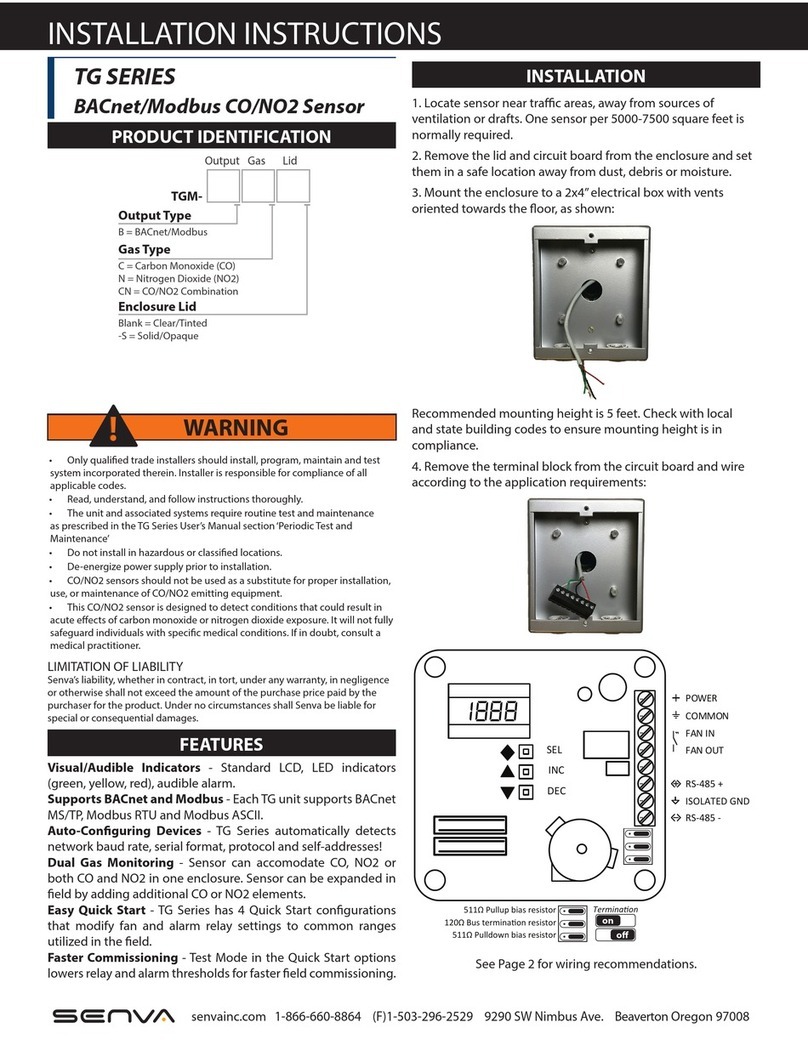
senva
senva TG Series User manual

senva
senva TG Series User manual

senva
senva TG Series User manual
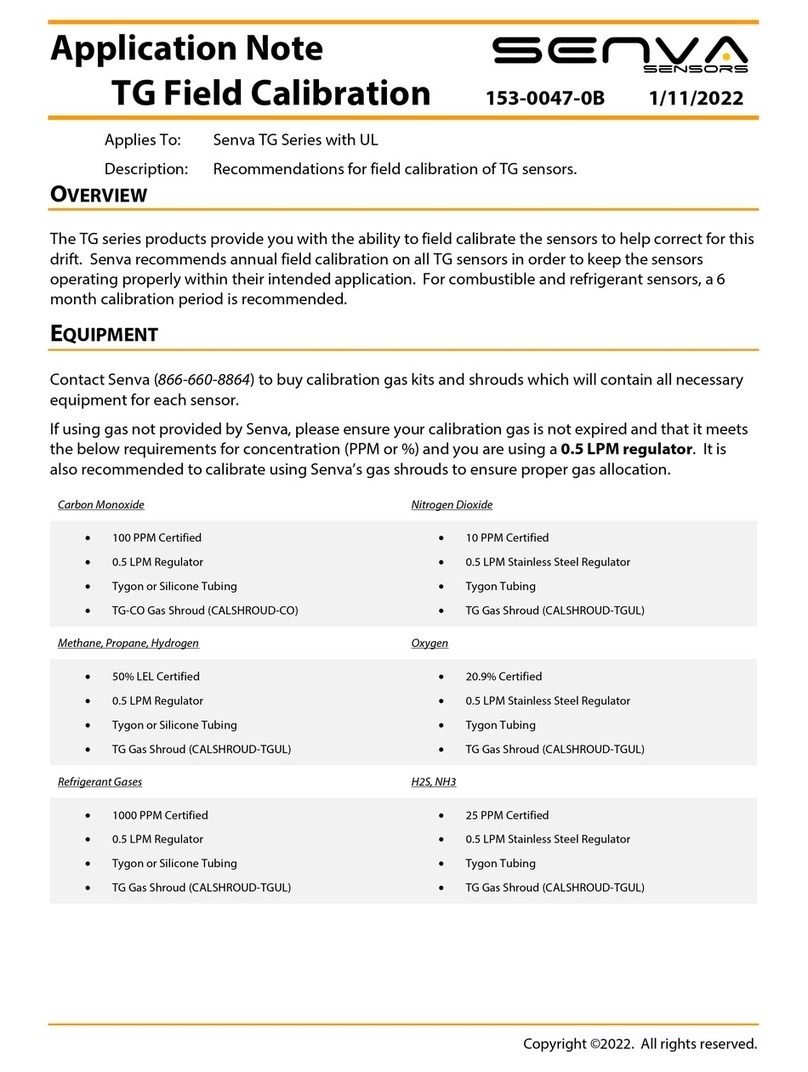
senva
senva TG Series Installation and operating instructions
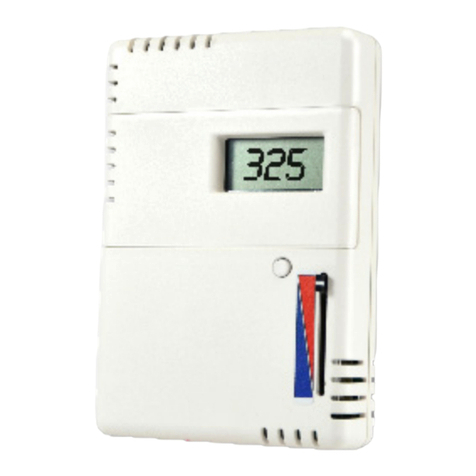
senva
senva CHTWL Series User manual

senva
senva TG Series User manual
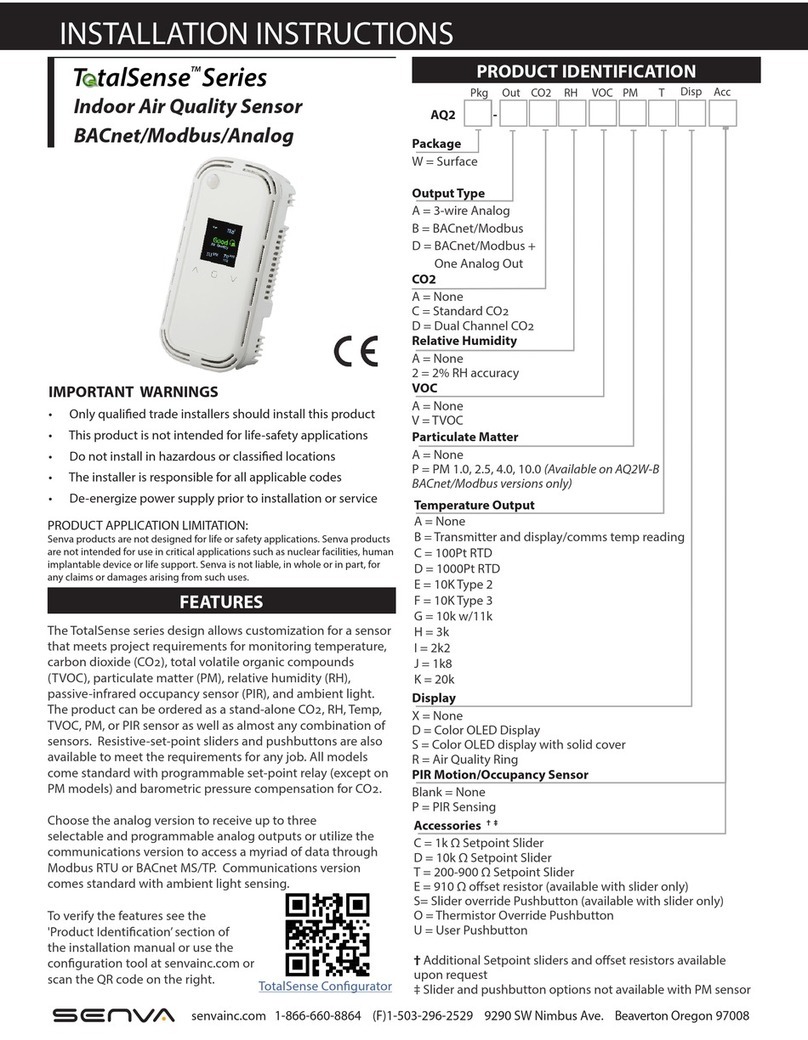
senva
senva TotalSense Series User manual

senva
senva TotalSense Series User manual
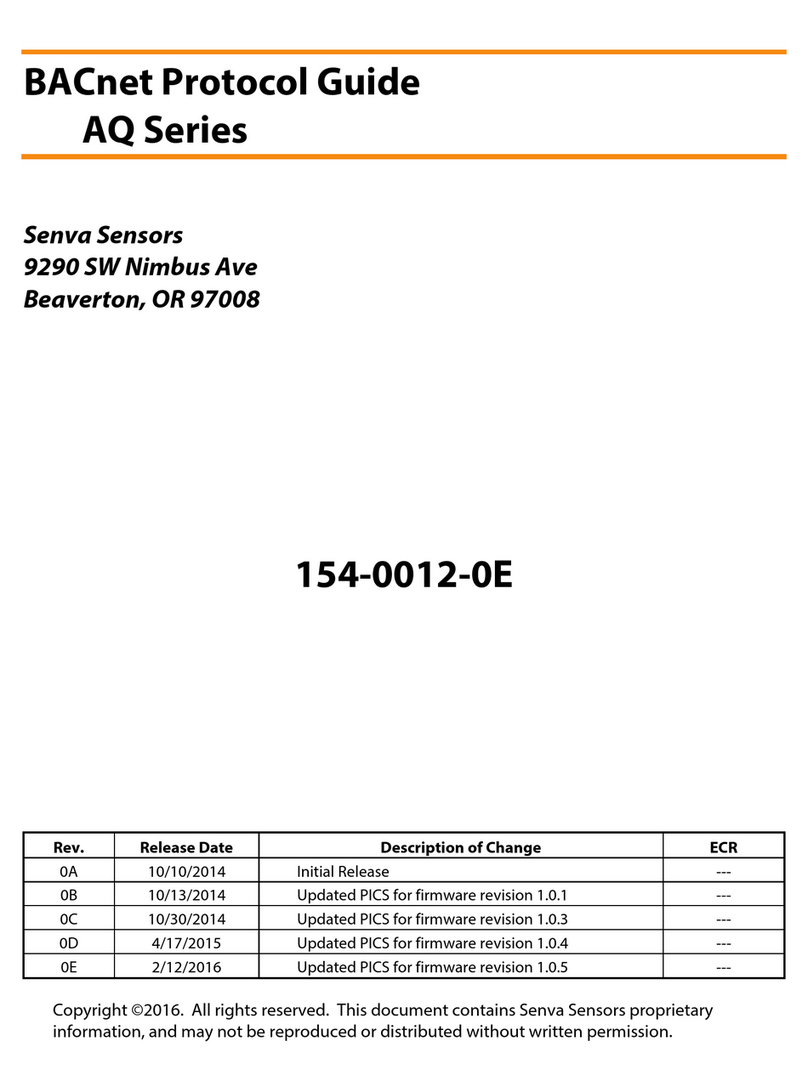
senva
senva AQ Series User manual

senva
senva TG Series User manual


















